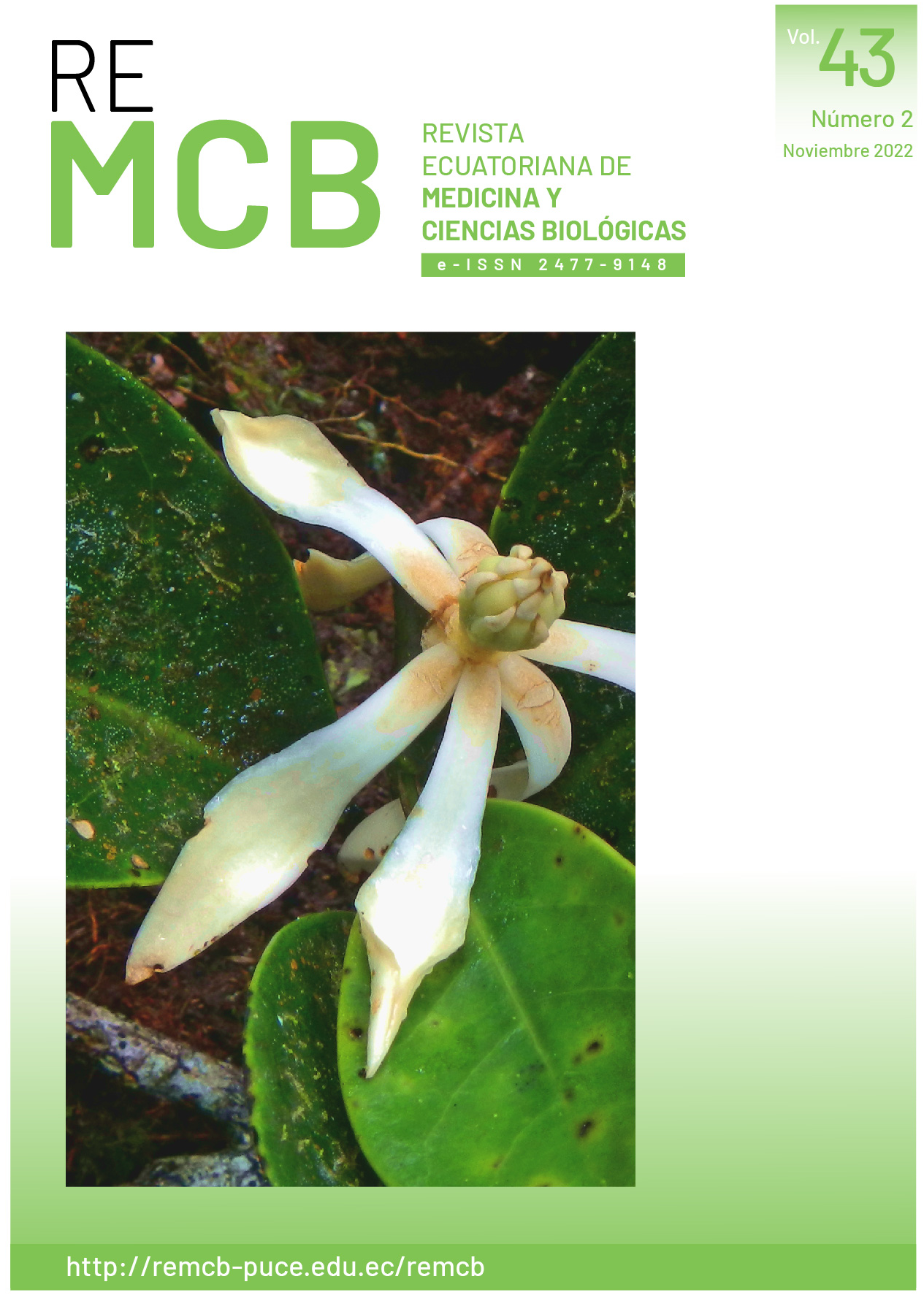Español
Main Article Content
Abstract
The purpose of the following article was to study how the change in land use, in a period of eleven years, (2008 - 2019), affects the potential distribution of the species Tremarctos ornatus (Andean bear) in the eastern foothills of Ecuador (Napo Province). According to the multi-temporal analysis of land use and cover in the province of Napo for the years 2008, 2018 and 2019, it is observed that this species lives near the páramo and the high montane forest (native forest). Although the category of high montane forest (native forest) has decreased over the years, the category of páramo has increased due to land use management. Analysis of the potential distribution model of the Andean bear at a local level indicate that Tremarctus ornatus can be found in Pichincha, Imbabura, Carchi, Napo, Cotopaxi, Chimborazo and Esmeraldas. In the province of Napo it is found in the cantons of: El Chaco, Quijos and Archidona, mainly in protected areas. The main threats faced by this species are hunting and the fragmentation of its habitat, so it must be protected, due to the ecological role it plays, as a seed disperser, mainly in moorland areas where there are greater records of its occurrence presence.
Downloads
Article Details

This work is licensed under a Creative Commons Attribution-NonCommercial 4.0 International License.
References
Camacho M. 2013. LOS PÁRAMOS ECUATORIANOS: CARACTERIZACIÓN Y CONSIDERACIONES PARA SU CONSERVACIÓN Y APROVECHAMIENTO SOSTENIBLE. ANALES de la Universidad Central del Ecuador.
Castellanos A. 2010. Guía para la rehabilitación, liberación y seguimiento de osos andinos. Andean Bear Foundation.
Castellanos A, Boada C. 2019. BIOWEB PUCE. Pontif Univ Católica Ecuad [Internet]. https://bioweb.bio/faunaweb/mammaliaweb/FichaEspecie/Tremarctos%20ornatus
Catalina Rivadeneira-Canedo. 2008. Study of the Andean bear (Tremarctos ornatus) as a legitimate seed disperser and elements of its diet in the region of Apolobamba-Bolivia. Ecología en Bolivia. 43(1):29–40.
Chuncho C, Chuncho G. 2019. Páramos del Ecuador, importancia y afectaciones: Una revisión. Bosques Latid Cero. 9(2):71–83.
Diego Ortiz Hernández, Jhon Fredy Ortiz. 2020. Modelado de distribución geográfica del oso andino bajo escenarios de cambio climático en Colombia. Bogotá: Universidad Antonio Nariño.
Evelyn Aldás. 2016. Modelamiento ecológico del hábitat del oso de anteojos (tremarctos ornatus) en el Parque Nacional Cayambe-Coca mediante el empleo de sistemas de información geográfica. Ibarra: Universida Técnica del Norte.
Fondo Ambiental Quito. 2021. Fondo Ambiental del Distrito Metropolitano de Quito. Fondo Ambient Quito [Internet]. http://www.fondoambientalquito.gob.ec/proyecto/conservacion-oso-andino-y-el-manejo-de-su-habitat-al-noroccidente-del-dmq
García-Rangel S. 2012. Andean bear Tremarctos ornatus natural history and conservation. Mammal Rev.:85–119.
Global Biodiversity Information Facility. 2021. Tremarctos ornatus (F.G.Cuvier, 1825). Glob Biodivers Inf Facil [Internet]. https://www.gbif.org/es/species/2433401
Gobierno Autónomo Descentralizado Provincial de Napo. 2019. PLAN DE DESARROLLO Y ORDENAMIENTO TERRITORIAL NAPO 2020-2023. Tena: Gobierno Autónomo Descentralizado Provincial de Napo.
Guillermo Armenta, Jorge Villa, Pablo Jácome. 2016. PROYECCIONES CLIMÁTICAS DE PRECIPITACIÓN Y TEMPERATURA PARA ECUADOR, BAJO DISTINTOS ESCENARIOS DE CAMBIO CLIMÁTICO.
Hofstede R, Segarra P, Mena P. 2003. Los Páramos del Mundo. Quito: Global Peatland Initiative/NC-IUCN/EcoCiencia.
iNaturalist. 2021. iNaturalist database. iNaturalist [Internet]. https://www.inaturalist.org/observations?place_id=any&taxon_id=41657
Judith Figueroa, Marcelo Stucchi, Roxana Rojas-VeraPinto. 2016. Modelación de la distribución del oso andino Tremarctos ornatus en el bosque seco del Maranón ˜ (Perú). Revista Mexicana de Biodiversidad. 87:230–238.
Kattan G, Hernández O, Goldstein I, Rojas V, Murillo O, Gómez C, Restrepo H, Cuesta F. 2004. Range fragmentation in the spectacled bear Tremarctos ornatus in the northern Andes. Oryx.
Lanly J-P. 2022. LOS FACTORES DE LA DEFORESTACIÓN Y DE LA DEGRADACIÓN DE LOS BOSQUES. Organ Las N U Para Aliment Agric [Internet]. https://www.fao.org/3/xii/ms12a-s.htm
Luis Suarez. 1988. Seasonal distribution and food habits of spectacled Bears Tremarctos ornatus in the highlands of Ecuador. Studies on Neotropical Fauna and Environment.:133–136.
Manuel Ruiz-García, Armando Castellanos, Jessica Yanina Arias-Vásquez, Joseph Mark Shostell. 2020. Genetics of the Andean bear (Tremarctos ornatus; Ursidae, Carnivora) in Ecuador: when the Andean Cordilleras are not an Obstacle [Internet]. Mitochondrial DNA Part A: DNA Mapping, Sequencing, and Analysis [Internet]. 31(5). https://doi.org/190-208
Ministerio de Agricultura y Ganadería. 2012. GEOPORTAL SIGTIERRAS. GEOPORTAL SIGTIERRAS [Internet]. http://www.sigtierras.gob.ec/geoportal/
Ministerio del Ambiente, Agua y Transición Ecológica. 2013. Sistema de Clasificación de Ecosistemas del Ecuador Continental. Quito: Subsecretaría de Patrimonio Natural.
Paola Parra. 2018. IDENTIFICACIÓN DE ÁREAS POTENCIALES PARA REFORESTACIÓN CON Nectandra acutifolia (PACCHES) MEDIANTE LA APLICACIÓN DE UN MODELO DE DISTRIBUCIÓN DE ESPECIES, COMO ESTRATEGIA DE CONSERVACIÓN PARA EL CORREDOR ECOLÓGICO DEL OSO ANDINO EN EL DISTRITO METROPOLITANO. Quito: Pontificia Universidad Católica del Ecuador.
Philips S, Dudik M, Schapire R. 2021. Software Maxent para el modelamiento de nichos y distribución de especies (Version 3.4.4) (3.4.4). [Internet]. https://biodiversityinformatics.amnh.org/open_source/maxent/
Pontificia Universidad Católica del Ecuador. 2021. Bioweb Ecuador. Bioweb Ecuad [Internet]. https://bioweb.bio/
Refoyo P, Olmedo C, Muñoz B. 2014. La utilidad de los modelos de distribución de especies en la gestión cinegética de los ungulados silvestres. Anim Biodivers Conserv. 37(2):165–176.
Sandoval P, Yánez P. 2019. ASPECTOS BIOLÓGICOS Y ECOLÓGICOS DEL OSO DE ANTEOJOS (Tremarctos ornatus, Ursidae) EN LA ZONA ANDINA DE ECUADOR Y PERSPECTIVAS PARA SU CONSERVACIÓN BAJO EL ENFOQUE DE ESPECIES PAISAJE. Granja Rev Cienc Vida.:19–27.
Sharon B. Phillips, Viney P. Aneja, Daiwen Kang, S. Pal Arya. 2006. Modelling and analysis of the atmospheric nitrogen deposition in North Carolina. International Journal of Global Environmental Issues. 6(2–3):231–252.
Tirira D. 2011. Libro Rojo de los Mamíferos del Ecuador. In: Libro Rojo Los Mamíferos Ecuad. 2a. edición. Quito: Fundación Mamíferos y Conservación.
Unión Internacional para la Conservación de la Naturaleza. 2017. IUCN RED LIST. IUCN RED LIST [Internet]. https://www.iucnredlist.org/species/22066/123792952
Ximena Velez-Liendo, Shaenandhoa García-Rangel. 2017. Tremarctos ornatus, Spectacled Bear. The IUCN Red List of Threatened Species.

